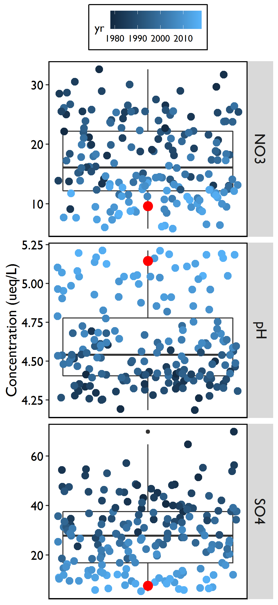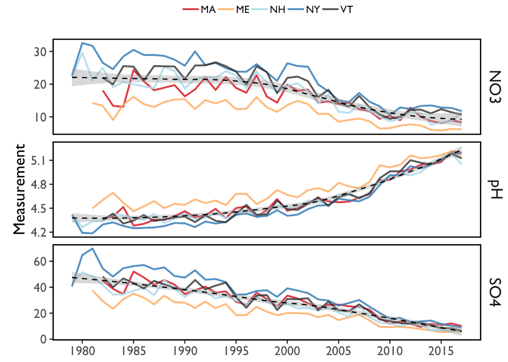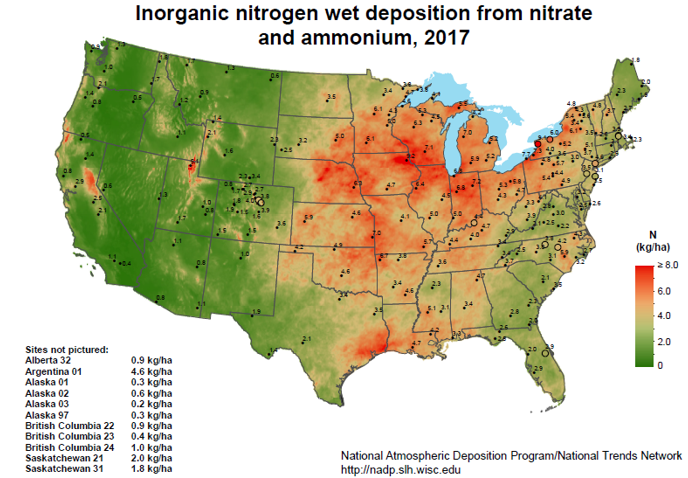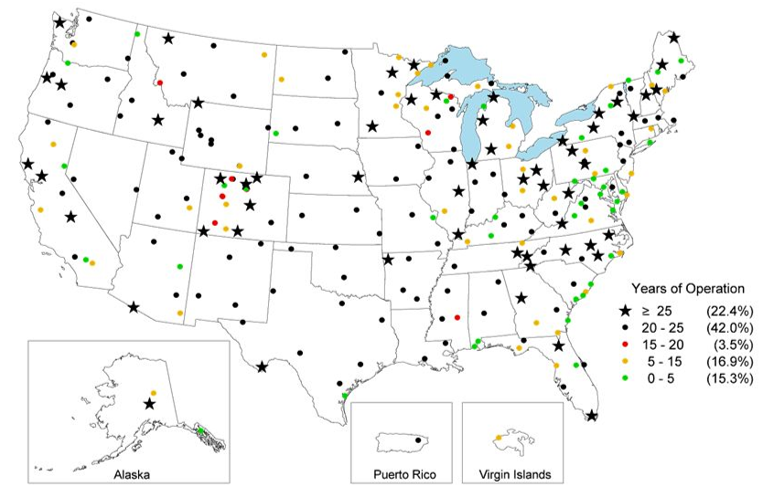Precipitation Chemistry and Acid Deposition
National Atmospheric Deposition Program/National Trends Network
The ecological consequences of atmospheric acid deposition have been well studied in the northeastern US. Acid rain has led to the decline of red spruce in the 1970s and 80s, the leaching loss of calcium and other cations from soil, and the acidification of lakes and streams. The continental scale of NTN sites reveals spatial and temporal trends in acid deposition in the Northeast and allows comparison with other regions of the U.S. Today, this information is necessary to understand how air quality policies have ameliorated acid deposition across the region, and to inform future policy and management decisions to sustain the health of the region’s forested ecosystems. Two measures of acid deposition are sulfate (SO42-) and nitrate (NO3-). When emitted as air pollutants, these molecules can form acids through reactions with water in the atmosphere, creating what we know as ‘acid rain’. Recognizing this serious environmental threat, regulations were enacted to control emissions of sulfur and nitrogen oxides, which react in the atmosphere to produce acidic compounds; as a result, acidic deposition has declined and ecosystem recovery is underway.
The Data

National Atmospheric Deposition Program (NADP) has been monitoring precipitation chemistry in the US since 1978 through the National Trends Network (NTN) program. The 250 national NTN sites collect data on the amounts, trends, and geographic distributions of acids, nutrients, and base cations in precipitation (Figure 1).
NTN sites are predominantly located away from urban areas and point sources of pollution. Each site is equipped with a precipitation chemistry collector and gage. The automated collector ensures that the sample is exposed only during precipitation (wet-only sampling). Site operators follow standard operational procedures to help ensure NTN data is comparable. All samples are analyzed and verified by the Central Analytical Laboratory (CAL) at the Illinois State Water Survey (ISWS). Measurements include acidity (H+ as pH), conductance, calcium (Ca2+), magnesium (Mg2+), sodium (Na+), potassium (K+), sulfate (SO42-), nitrate (NO3-), chloride (Cl-), and ammonium (NH4+). Deposition is the total amount of a pollutant deposited through rainfall, but to remove variability from precipitation patterns, we report trends in concentrations of pollutants.
This report details current year and long-term trend statistics for Maine, Massachusetts, New Hampshire, New York and Vermont.
2017 in Summary
For all three metrics of acid deposition (NO3-, pH, SO42-), 2017 continued the trend of reduced concentration compared to the high values experienced in the historical record (Figure 2). The lowest amount of nitrate concentration in the regional record occurred in 2010 (8.8 ueq/L), signaling a considerable decline from a peak of 32.0 ueq/L in 1980 (Figure 3). However, following this nadir in 2010, NO3- concentration rose slightly and then plateaued. Yet, during this period, NO3- concentration continued to remain much reduced compared to the historical record. In 2017, we again saw a decline in concentration, with the second lowest amount in the record (10.1 ueq/L; Figure 2, Figure 3). This may signal improved reductions in other sources of nitrate emissions.
In comparison, 2017 marked the lowest mean sulfate concentration in the regional record (8.3 ueq/L), which continued the trend begun in 2015 of lower sulfate concentration compared to nitrate (Figure 3). This a considerable decline from peak sulfate concentration in 1980 of 62.0 ueq/L.
The regional average pH was the second highest in the record at 5.17. While 2016 marked the highest pH value in the record (5.19) the average value in 2017 was nearly the same as the previous year. These results indicate that precipitation in the form of rain, snow, or ice is less acidic than in the historical record and improvements on limiting acidic emissions are working. However, while the pH has increased considerably from the record’s low of 4.2 in 1980, “unpolluted” rain typically has a pH of 5.6; therefore, there is still room for improvement in lowering the acidity of precipitation. As pH is a logarithmic scale, this increase represents a roughly fivefold improvement in precipitation acidity.

In the early years of acid rain monitoring, sulfates accounted for about 66% of the acidity in precipitation, while nitrates contribute the other 33%. While upwind emissions of both sulfur oxides (SOX) and nitrogen oxides (NOX) have declined over time, reductions in SOX have been greater than NOX. While the stress imposed by SOx deposition has been greatly reduced, it is unclear how the continued deposition of NOx will impact forested ecosystems. Further, it is unclear how low these values could fall before they plateau; indeed, this may have already occurred for deposition of nitrate.
Long-term Trends
Since precipitation chemistry was first measured in the region, rain has become less acidified (Figure 3). These changes reflect declines in sulfur- and nitrogen-based emissions due to the Clean Air Act (1977) and subsequent amendments (1990). The most significant reductions have occurred for sulfate concentration, which has fallen from nearly 62.0 ueq/L in 1980 to less than 9 ueq/L currently. Concurrently, there has been a dramatic increase in precipitation pH (Figure 3). Note that for certain years, there is higher variability, which shows the variation in the region based on aspect and location of the monitoring site (see Figure 4). Sulfuric emissions have been easier to control through regulation of emissions from the burning of coal, natural gas, and other fossil fuels. Looking forward, it is likely that reductions in SO42- may continue (Figure 3), along with resultant decreases in precipitation acidity.
More modest changes have been measured for nitrate deposition (Figure 3) and it appears that reductions in NO3- concentrations may have plateaued. This is primarily due to the relative difficulty of removing nitrogen compounds from flue gases and their diffuse pollution sources such as motor vehicle exhaust and agricultural activities. This diffuse nature of nitrogenous pollution means that continued reductions may require additional legislative or regulatory action.

Implications
The region is in relatively good shape compared to nitrogen pollution loads nationwide (Figure 4). However, high elevation forests are still at risk from additional acidic inputs due to more frequent exposure to acid mist in clouds, higher amounts of precipitation, and relatively shallow, acidic soils. Further, there are some areas of the region, particularly western and southern portions of New York, which have continued to receive elevated nitrogen deposition (Figure 4)
As nitrogen becomes a more important constituent of acid deposition, monitoring networks and modelers are combining resources to better understand the spatial and temporal patterns of nitrogen deposition and its impacts on terrestrial and aquatic ecosystems. Continued reductions in nitrogen deposition may require additional regulation to control widely dispersed sources.

Acid deposition continued to decline in 2017. The average pH of precipitation was 5.1, well above the historical low. Nitrate deposition reductions may have plateaued and should continue to be monitored.

Acid deposition continued to decline in 2017. The average pH of precipitation was 5.1, well above the historical low. Nitrate deposition reductions may have plateaued and should continue to be monitored.
Additional Resources
- National Atmpospheric Deposition Program. http://nadp.sws.uiuc.edu/NTN/
- EARTH: The Science Behind the Headlines. American Geosciences Institute. http://www.earthmagazine.org/
FEMC Project Database Link
- National Atmospheric Deposition Program/National Trends Network (NADP/NTN) https://www.uvm.edu/femc/data/archive/project/national-atmospheric-deposition-programnational-trends-network

